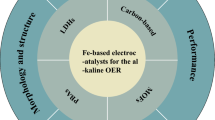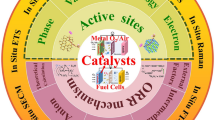Abstract
Photo-electrochemical properties of fluorine-doped tin oxide (FTO)/nickel oxide-nickel (Ni0.98Si0.02O2-Ni) with isolated Si sites are discussed. The Ni0.98Si0.02O2-Ni photo-electrocatalyst without any noble metal was prepared using a one-step chemical reduction precipitation method. Photo-electrochemical properties were investigated by cyclic voltammetry and chronoamperometry techniques in aqueous alkaline solution at pH 8.0. The photo-electrochemical response of the catalyst showed sensitivity to visible and UV light. The catalyst produced hydrogen from water at a rate of 0.5 mmol g−1 h−1 with the reduction of CO2 into CO under visible light in the absence of any light sensitizer or a noble metal. The metallic Ni amount in the catalyst system was optimized to obtain the best photo-electrocatalyst. The first principle DFT study showed that the incorporation of Si sites allowed absorbance of visible light. The catalyst was characterized by powder x-ray diffraction (PXRD), scanning electron microscope (SEM), transmission electron microscope (TEM), X-ray photoelectron spectroscopy (XPS), inductively coupled plasma- atomic emission spectroscopy (ICP-AES), Brunauer–Emmett–Teller (BET), cyclic voltammetry, and chronoamperometry. The products were analyzed by gas chromatography- thermal conductivity detector (GC-TCD).
Graphic Abstract












Similar content being viewed by others
References
Fujishima A, Honda K (1972) Electrochemical photolysis of water at a semiconductor electrode. Nature 238(5358):37
Ashokkumar M (1998) An overview on semiconductor particulate systems for photoproduction of hydrogen. Int J Hydrog Energy 23(6):427–438
Kudo A (2007) Recent progress in the development of visible light-driven powdered photocatalysts for water splitting. Int J Hydrog Energy 32(14):2673–2678
Maeda K, Domen K (2007) New non-oxide photocatalysts designed for overall water splitting under visible light. J Phys Chem C 111(22):7851–7861
Domen K, Kudo A, Shinozaki A, Tanaka A, Maruya KI, Onishi T (1986) Photodecomposition of water and hydrogen evolution from aqueous methanol solution over novel niobate photocatalysts. J Chem Soc Chem Commun 4:356–357
Sato S, White J (1980) Photodecomposition of water over Pt/TiO2 catalysts. Chem Phys Lett 72(1):83–86
Kudo A, Kato H (1997) Photocatalytic decomposition of water into H2 and O2 over novel photocatalyst K3Ta3Si2O13 with pillared structure consisting of three TaO6 chains. Chem Lett 26(9):867–868
Sato J, Saito N, Nishiyama H, Inoue Y (2001) New photocatalyst group for water decomposition of RuO2-loaded p-block metal (In, Sn, and Sb) oxides with d10 configuration. J Phys Chem B 105(26):6061–6063
Yadav R, Sinha AK (2017) Titania cowrapped α-sulfur composite as a visible light active photocatalyst for hydrogen evolution using in situ methanol from CO2 as a sacrificial agent. ACS Sustain Chem Eng 5(8):6736–6745
Yadav R, Amoli V, Singh J, Tripathi MK, Bhanja P, Bhaumik A, Sinha AK (2018) Plasmonic gold deposited on mesoporous TixSi1−xO2 with isolated silica in lattice: an excellent photocatalyst for photocatalytic conversion of CO2 into methanol under visible light irradiation. J CO2 Util 27:11–21
Awais M, Dini D, MacElroy JD, Halpin Y, Vos JG, Dowling DP (2013) Electrochemical characterization of NiO electrodes deposited via a scalable powder microblasting technique. J Electroanal Chem 689:185–192
Marrani AG, Novelli V, Sheehan S, Dowling DP, Dini D (2013) Probing the redox states at the surface of electroactive nanoporous NiO thin films. ACS Appl Mater Interfaces 6(1):143–152
Decker F, Passerini S, Pileggi R, Scrosati B (1992) The electrochromic process in non-stoichiometric nickel oxide thin film electrodes. Electrochim Acta 37(6):1033–1038
Awais M, Dowling DD, Rahman M, Vos JG, Decker F, Dini D (2013) Spray-deposited NiO x films on ITO substrates as photoactive electrodes for p-type dye-sensitized solar cells. J Appl Electrochem 43(2):191–197
Sheehan S, Naponiello G, Odobel F, Dowling DP, Di Carlo A, Dini D (2015) Comparison of the photoelectrochemical properties of RDS NiO thin films for p-type DSCs with different organic and organometallic dye-sensitizers and evidence of a direct correlation between cell efficiency and charge recombination. J Solid State Electrochem 19(4):975–986
Mitoff S (1961) Electrical conductivity and thermodynamic equilibrium in nickel oxide. J Chem Phys 35(3):882–889
Boschloo G, Hagfeldt A (2001) Spectroelectrochemistry of nanostructured NiO. J Phys Chem B 105(15):3039–3044
D’Amario L, Boschloo G, Hagfeldt A, Hammarström L (2014) Tuning of conductivity and density of states of NiO mesoporous films used in p-type DSSCs. J Phys Chem C 118(34):19556–19564
O’regan B, Grätzel M (1991) A low-cost, high-efficiency solar cell based on dye-sensitized colloidal TiO2 films. Nature 353(6346):737
He J, Lindstrom H, Hagfeldt A, Lindquist SE (2000) Dye-sensitized nanostructured tandem cell-first demonstrated cell with a dye-sensitized photocathode. Sol Energy Mater Sol Cells 62:265–273
Awais M, Gibson E, Vos JG, Dowling DP, Hagfeldt A, Dini D (2014) Fabrication of efficient NiO photocathodes prepared via RDS with novel routes of substrate processing for p-type dye-sensitized solar cells. ChemElectroChem 1(2):384–391
Gibson EA, Awais M, Dini D, Dowling DP, Pryce MT, Vos JG, Boschloo G, Hagfeldt A (2013) Dye sensitised solar cells with nickel oxide photocathodes prepared via scalable microwave sintering. PCCP 15(7):2411–2420
Awais M, Dowling DP, Decker F, Dini D (2015) Electrochemical characterization of nanoporous nickel oxide thin films spray-deposited onto indium-doped tin oxide for solar conversion scopes. Adv Condens Matter Phys. https://doi.org/10.1155/2015/186375
Lewerenz HJ, Peter L (eds) (2013) Photoelectrochemical water splitting: materials, processes and architectures. Royal Society of Chemistry, Cambridge
Lewis NS (2007) Toward cost-effective solar energy use. Science 315(5813):798–801
Koffyberg F, Benko F (1981) p-type NiO as a photoelectrolysis cathode. J Electrochem Soc 128(11):2476–2479
Kim H-S, Park JE, Patel M, Kim H, Kim DS, Byeon SK, Lim D, Kim J (2016) Optically transparent and electrically conductive NiO window layer for Si solar cells. Mater Lett 174:10–13
Yu Y, Xia Y, Zeng W, Liu R (2017) Synthesis of multiple networked NiO nanostructures for enhanced gas sensing performance. Mater Lett 206:80–83
Wang W, Zhang W, Hao C, Wu F, Liang Y, Shi H, Wang J, Zhang T, Hua Y (2016) Enhanced photoelectrochemical activity and photocatalytic water oxidation of NiO nanoparticle-decorated SrTiO3 nanocube heterostructures: interaction, interfacial charge transfer and enhanced mechanism. Sol Energy Mater Sol Cells 152:1–9
da Silva MR, Neto VSL, Lucilha AC, de Andrade Scalvi LV, Dall’Antonia LH (2015) Photoelectrochemical properties of FTO/p-NiO electrode induced by UV light irradiation. Ionics 21(5):1407–1415
Patel M, Kim H-S, Kim J, Yun J-H, Kim SJ, Choi EH, Park H-H (2017) Excitonic metal oxide heterojunction (NiO/ZnO) solar cells for all-transparent module integration. Sol Energy Mater Sol Cells 170:246–253
Patel M, Kim J (2017) Transparent NiO/ZnO heterojunction for ultra-performing zero-bias ultraviolet photodetector on plastic substrate. J Alloys Compd 729:796–801
Sahara G, Abe R, Higashi M, Morikawa T, Maeda K, Ueda Y, Ishitani O (2015) Photoelectrochemical CO2 reduction using a Ru (ii)–Re (i) multinuclear metal complex on a p-type semiconducting NiO electrode. Chem Commun 51(53):10722–10725
Sápi A, Varga A, Samu GF, Dobó D, Juhász KL, Takács B, Varga E, Kukovecz Á, Kónya Z, Janáky C (2017) Photoelectrochemistry by design: tailoring the nanoscale structure of Pt/NiO composites leads to enhanced photoelectrochemical hydrogen evolution performance. J Phys Chem C 121(22):12148–12158
Yasumura J (1954) Thermal treatment of raney nickel catalyst. Nature 173(4393):80
Nelson NC, Ruberu TPA, Reichert MD, Vela J (2013) Templated synthesis and chemical behavior of nickel nanoparticles within high aspect ratio silica capsules. J Phys Chem C 117(48):25826–25836
Clark SJ, Segall MD, Pickard CJ, Hasnip PJ, Probert MI, Refson K, Payne MC (2005) First principles methods using CASTEP. Z Krist Cryst Mater 220(5/6):567–570
Yang D, Chen C, Zheng Z, Liu H, Waclawik ER, Yan Z, Huang Y, Zhang H, Zhao J, Zhu H (2011) Grafting silica species on anatase surface for visible light photocatalytic activity. Energy Environ Sci 4(6):2279–2287
Pitts J, Thomas T, Czanderna A, Passler M (1986) XPS and ISS of submonolayer coverage of Ag on SiO2. Appl Surf Sci 26(1):107–120
Dong Y, Wu R, Jiang P, Wang G, Chen Y, Wu X, Zhang C (2015) Efficient photoelectrochemical hydrogen generation from water using a robust photocathode formed by CdTe QDs and nickel ion. ACS Sustain Chem Eng 3(10):2429–2434
Poldme N, O’Reilly L, Fletcher I, Portoles J, Sazanovich IV, Towrie M, Long C, Vos JG, Pryce MT, Gibson EA (2019) Photoelectrocatalytic H2 evolution from integrated photocatalysts adsorbed on NiO. Chem Sci 10(1):99–112
Hu C, Chu K, Zhao Y, Teoh WY (2014) Efficient photoelectrochemical water splitting over anodized p-type NiO porous films. ACS Appl Mater Interfaces 6(21):18558–18568
Gross MA, Creissen CE, Orchard KL, Reisner E (2016) Photoelectrochemical hydrogen production in water using a layer-by-layer assembly of a Ru dye and Ni catalyst on NiO. Chem Sci 7(8):5537–5546
Dai W-X, Zhang L, Zhao W-W, Yu X-D, Xu J-J, Chen H-Y (2017) Hybrid PbS quantum dot/nanoporous NiO film nanostructure: preparation, characterization, and application for a self-powered cathodic photoelectrochemical biosensor. Anal Chem 89(15):8070–8078
Li Y, Zhang X, Jiang S, Dai H, Sun X, Li Y (2015) Improved photoelectrochemical property of a nanocomposite NiO/CdS@ ZnO photoanode for water splitting. Sol Energy Mater Sol Cells 132:40–46
Dong Y, Chen Y, Jiang P, Wang G, Wu X, Wu R, Zhang C (2015) Efficient and stable MoS2/CdSe/NiO photocathode for photoelectrochemical hydrogen generation from water. Chem An Asian J 10(8):1660–1667
Author information
Authors and Affiliations
Corresponding author
Additional information
Publisher's Note
Springer Nature remains neutral with regard to jurisdictional claims in published maps and institutional affiliations.
Rights and permissions
About this article
Cite this article
Yadav, R., Singh, H., Saini, S. et al. Photo-electrochemical hydrogen evolution over FTO/Ni0.98Si0.02O2-Ni electrode induced by visible and UV light irradiation. J Appl Electrochem 49, 991–1002 (2019). https://doi.org/10.1007/s10800-019-01340-z
Received:
Accepted:
Published:
Issue Date:
DOI: https://doi.org/10.1007/s10800-019-01340-z




